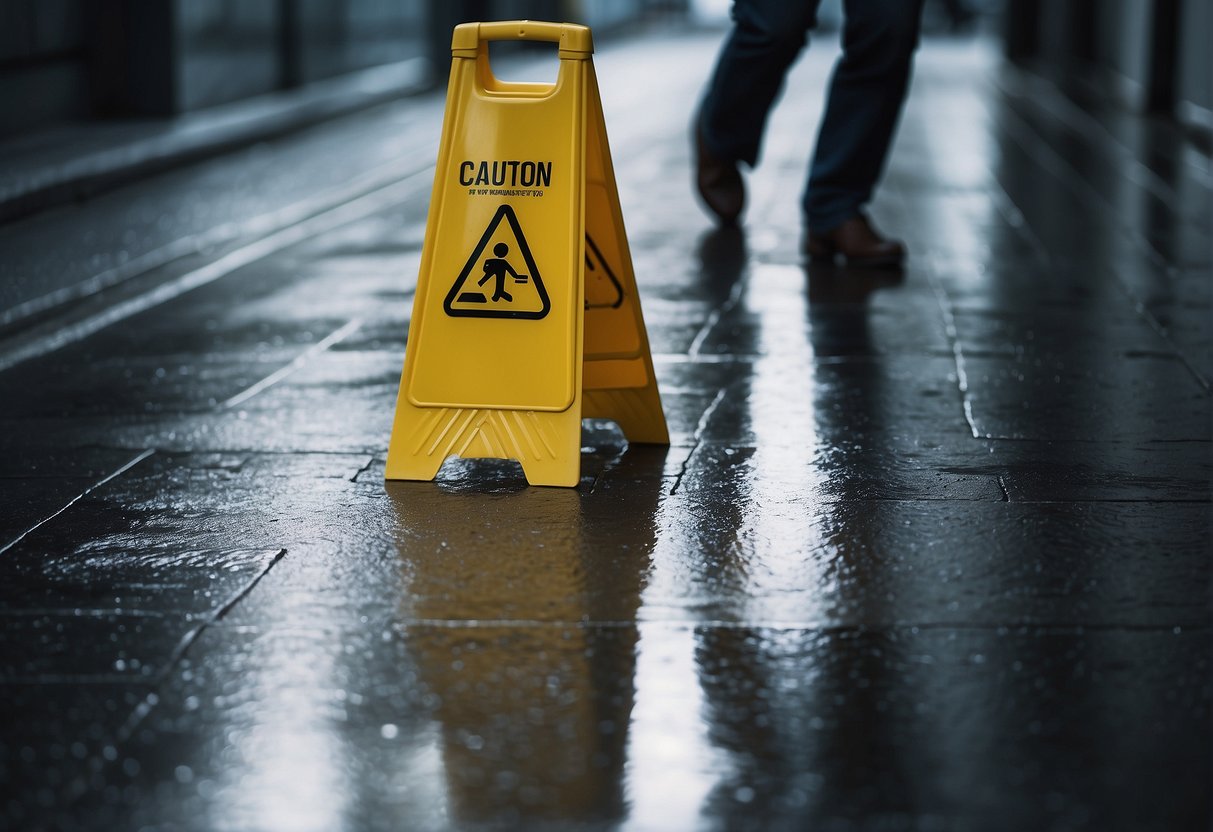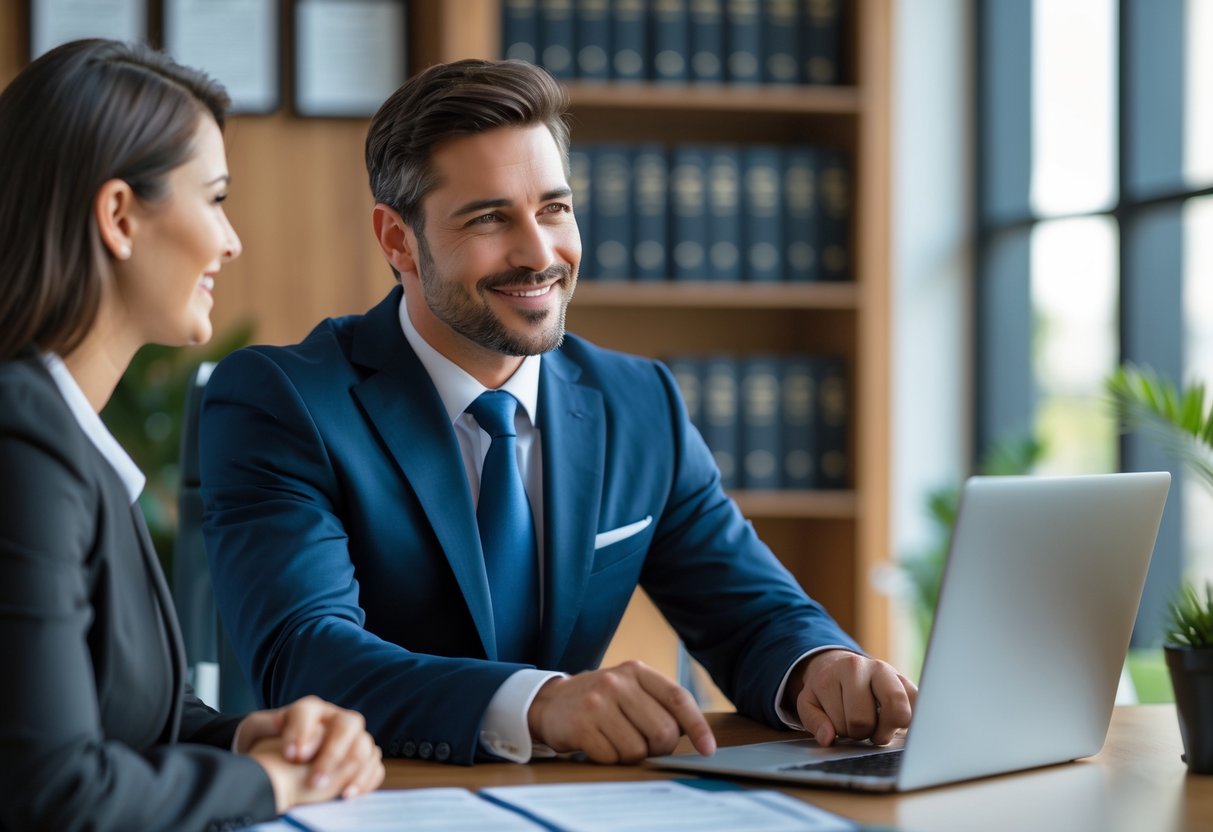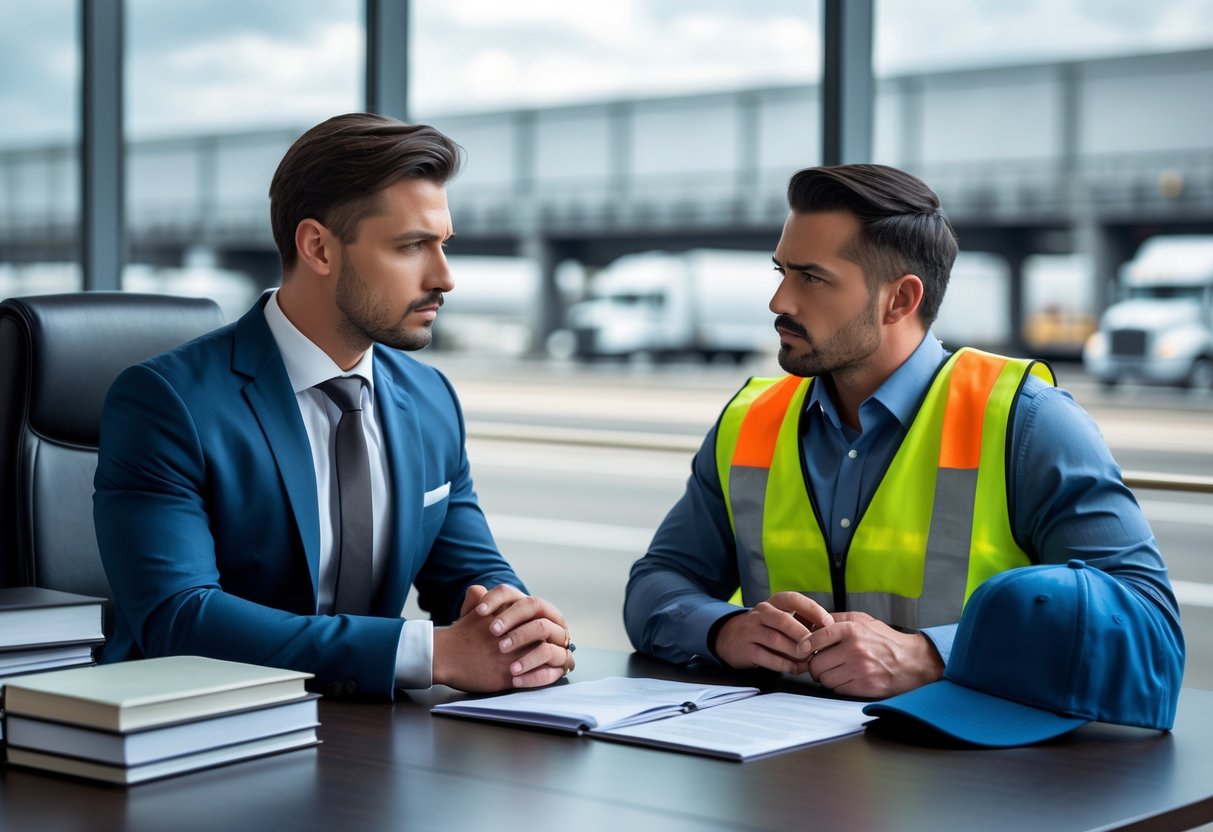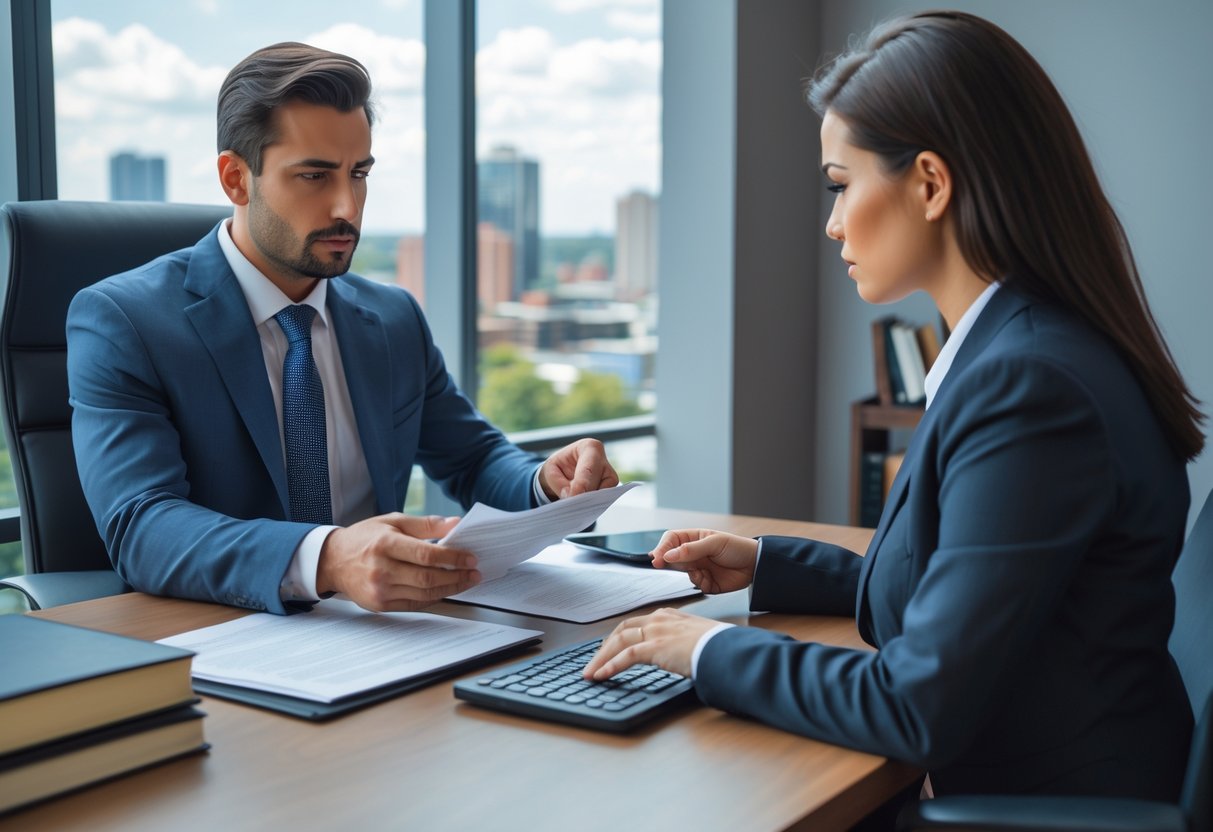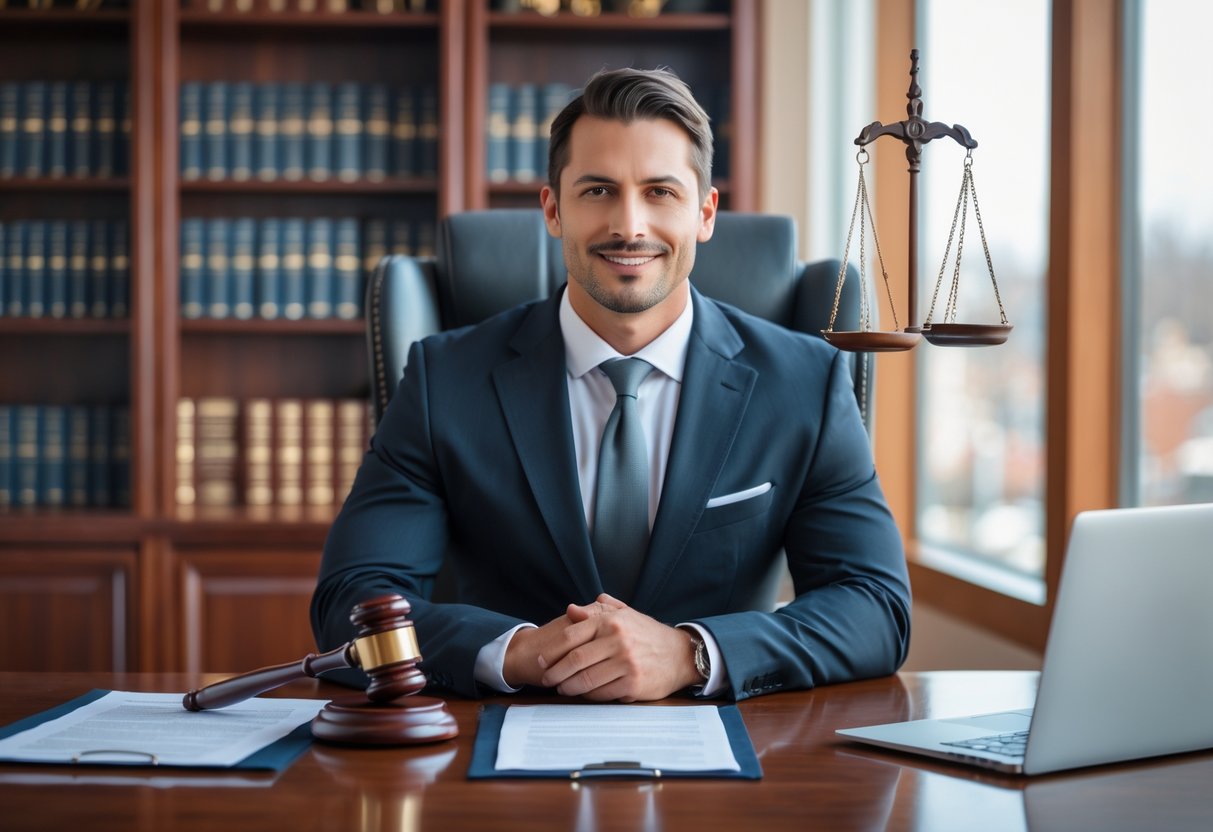Understanding Slip and Fall Accidents

Slip and fall accidents are a significant concern in public and private spaces, often leading to serious injuries. We will explore what constitutes these incidents and the typical conditions that contribute to such accidents.
Defining Slip and Fall Incidents
Slip and fall accidents occur when an individual loses their footing and falls due to an unsafe condition on the property. These events particularly involve situations where friction between the footwear and the walking surface is insufficient, leading to a loss of balance. We often see slip and fall claims in personal injury law, as the incidents are usually preventable and can have serious health consequences.
Common Causes and Hazardous Conditions
Common Causes:
- Uneven Flooring: Differences in floor height or irregular surfaces.
- Wet Floors: Moisture or spills without proper signage or cleanup.
- Obstructions: Loose cables, rugs, or clutter impeding walkways.
Hazardous Conditions:
- Poor Lighting: Inadequately lit areas mask potential dangers.
- Spills: Liquids left unattended can create a slip risk.
- Outdoor Elements: Weather-related conditions such as ice or snow.
The presence of these hazards underscores the need for regular maintenance and immediate attention to potential dangers. By addressing these risks proactively, we can reduce the likelihood of slip and fall accidents significantly.
Legal Fundamentals of Premises Liability
In this section, we explore the essential legal concepts surrounding premises liability, focusing on the roles and responsibilities that property owners and visitors assume under the law.
Duty of Care and Breach
Duty of Care: When it comes to premises liability, we observe that property owners must maintain a reasonable standard of care to ensure the safety of visitors. This obligation means that hazards should be identified and rectified or at least adequately signaled to prevent accidents.
Breach of Duty: If a property owner fails to uphold this standard and a guest is injured as a result, that is considered a breach of duty of care. An overlooked spill that leads to a fall is a common example of such a breach.
Property Owner’s Responsibility
Liability: We note that property owners are responsible for the conditions on their premises. This liability extends to both fixing known hazards and regularly inspecting for potential dangers.
Knowledge and Care: In assessing liability, we consider whether the owner was aware, or ought to have been aware, of the dangerous condition and did not take appropriate actions to mitigate risk.
Visitor’s Rights
Negligence: We recognize that visitors have the right to seek compensation if they are injured due to a property owner’s negligence. Demonstrating that the owner knew about the danger but did not act can help establish negligence.
Responsibility: Visitors themselves also have the responsibility to exercise care and avoid obvious hazards. Their rights are balanced with a requirement to act reasonably under the circumstances.
Building a Strong Slip and Fall Claim

To build a robust slip and fall claim, we must focus on meticulous evidence collection, timely medical attention, and thorough documentation. These elements are critical in establishing the validity of our claim and enhancing the chances of successful compensation.
Evidence and Documentation
Gathering evidence is the foundation of our slip and fall claim. It starts at the scene of the accident where we collect every piece of information that can support our case:
- Immediate Scene Photos: Capture the area where the slip and fall occurred, including any conditions that contributed to the accident.
- Incident Report: Obtain or file a report with the property owner or manager detailing the incident.
- Documentation: Preserve all communication and paperwork related to the incident, such as emails and written notices.
Medical Treatment and Records
Seeking medical attention immediately after a slip and fall accident not only ensures our well-being but also generates critical medical records that serve as evidence:
- Doctor Visits: Visit a doctor immediately to diagnose and document any injuries from the fall.
- Medical Reports: Collect all medical reports and bills, which will link the accident to our injuries.
- Follow-up Treatments: Keep records of any ongoing treatments or therapies.
Witness Statements and Photos
Witness statements and photos can powerfully corroborate our version of the events:
- Identify Witnesses: List names and contact information of anyone who saw the accident.
- Collect Statements: Ask witnesses to provide a detailed account as soon as possible when their memory is fresh.
- Photographic Evidence: Supplement witness statements with photos of the accident scene from different angles and lighting conditions, if available.
By adhering to these steps, we enhance the credibility and strength of our slip and fall claim.
Seeking Compensation

When pursuing compensation for slip and fall accidents, our primary goal is to ensure that we are rightfully compensated for all damages and losses incurred. We must accurately calculate what is owed to us, navigate negotiations with insurance companies, and often rely on the expertise of personal injury lawyers to strengthen our case.
Determining Damages and Losses
Identifying and quantifying the compensation we are entitled to involves a meticulous analysis of our economic and non-economic damages. Economic damages are our tangible losses, which include:
- Medical expenses: Bills for hospital stays, doctor visits, physical therapy, medication, and any future medical care related to the injury.
- Lost wages: Income we’ve missed out on due to time off work, and potentially, the loss of earning capacity if we are unable to return to work.
In addition to economic damages, we must consider non-economic damages, which are more subjective and include:
- Pain and suffering: This refers to the physical discomfort and emotional distress experienced.
For a precise assessment, we may need to consult with medical professionals and financial experts.
Negotiating with Insurers
Engaging in discussions with an insurance company is a critical stage in obtaining compensation. The process looks like this:
- Submitting a thorough claim to the insurer, detailing all damages and providing supporting documents.
- Reviewing the insurance company’s settlement offer and determining if it fully covers our losses.
- Counter-offering if the initial settlement is unsatisfactory, with a clear rationale and evidence supporting our valuation.
Our ability to negotiate effectively can significantly influence the compensation we receive.
The Role of Personal Injury Lawyers
Enlisting a personal injury lawyer enhances our ability to navigate the legal complexities and improve the chances of securing adequate compensation. Their roles include:
- Providing legal advice tailored to our specific case.
- Representing us in dealings with insurance companies.
- Filing a lawsuit and advocating for us in court if necessary.
A seasoned lawyer can leverage their knowledge and experience to argue for comprehensive reparation that accounts for all our losses.
Navigating the Legal Process
Navigating the legal process requires understanding the specific steps involved in seeking compensation after a slip and fall accident. We aim to guide you through consultations and securing legal representation, outline the filing and litigation procedures, and explain the importance of statutes of limitations.
Consultations and Legal Representation
The first step in pursuing a legal claim is to consult with a personal injury attorney experienced in slip and fall cases. During this initial meeting, we will:
- Discuss the facts of your case and assess its merits
- Advise on the legal strategies that may be available to you
It’s crucial to choose legal representation that is skilled and has a track record of success in similar cases. Our experience can significantly influence the outcome of your case.
Filing and Litigation Procedures
Once we decide to proceed, the formal legal process begins with the filing of a complaint in the appropriate court. The key stages include:
- Drafting and filing a complaint outlining your allegations and damages
- Discovery, where we exchange information with the defense
- Pre-trial motions and, if necessary, trial proceedings
These steps require meticulous attention to detail and adherence to procedural rules, where our expertise in litigation proves essential.
Understanding Statutes of Limitations
Our awareness of the relevant statute of limitations is paramount in slip and fall cases. This is the time frame in which you are legally permitted to file a lawsuit. Key points about statutes of limitations include:
- Varies by jurisdiction but generally ranges from 1 to 6 years
- Failure to file within this period typically results in losing the right to sue
We keep track of these deadlines to ensure that your legal action is timely and preserves your rights to compensation.
Frequently Asked Questions
In providing answers to common queries, we offer clarity on financial recoveries associated with slip and fall incidents.
What factors determine the settlement amount in a slip and fall case?
The settlement amount in a slip and fall case is influenced by multiple factors including the severity of the injury, medical expenses incurred, lost wages, future medical treatment, and the impact on the victim’s quality of life. Liability and negligence also play critical roles in the determination of the settlement.
Can I receive compensation for a slip and fall accident without undergoing surgery?
Yes, compensation for a slip and fall accident can be sought for injuries that do not require surgery. The amount may be affected by the injury’s severity and the cost of alternative medical treatments, as well as other non-surgical care expenses.
What constitutes negligence in a slip and fall case?
Negligence in a slip and fall case occurs when a property owner fails to maintain a safe environment, leading to an accident. This could include slippery surfaces without warning signs, obstructions on pathways, or inadequate lighting that contribute to the incident.
How is pain and suffering calculated in slip and fall compensation?
Pain and suffering in slip and fall compensation is typically calculated using either a multiplier method, where actual damages such as medical bills and lost wages are multiplied by a number determined by the severity of pain, or a per diem method that assigns a daily value to pain and multiplies it by the number of days affected.
Why is it challenging to win slip and fall lawsuits?
Winning slip and fall lawsuits can be challenging due to the need to clearly prove property owner negligence, demonstrate that the hazardous condition was not obvious, and establish that the victim took reasonable steps to avoid injury. Defendants often argue that the victim holds some responsibility for the accident.
What are some examples of high-value slip and fall settlements?
High-value slip and fall settlements often involve severe, long-lasting injuries with substantial medical expenses. For instance, cases with traumatic brain injuries or spinal cord damages that cause significant disability and require lifelong care sometimes result in multi-million dollar settlements.
